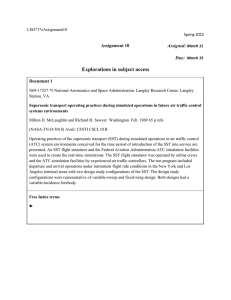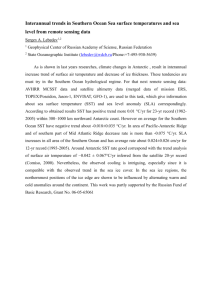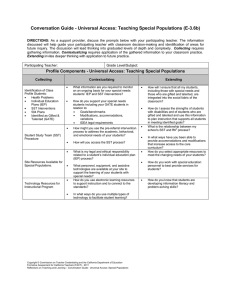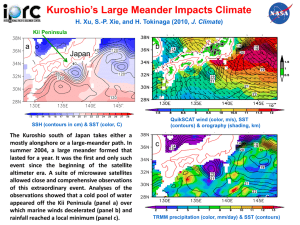Coupled Interactions Between Surface Winds and Sea Surface Temperature Larry W. O’Neill
advertisement
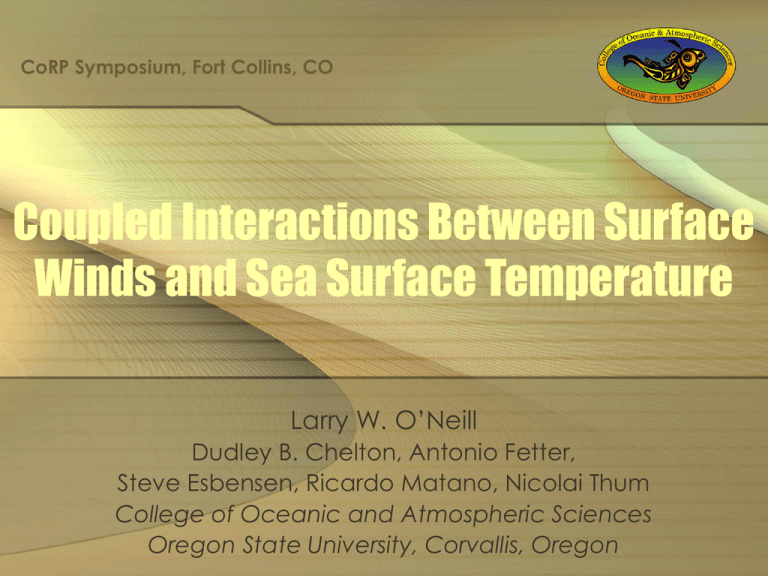
CoRP Symposium, Fort Collins, CO Coupled Interactions Between Surface Winds and Sea Surface Temperature Larry W. O’Neill Dudley B. Chelton, Antonio Fetter, Steve Esbensen, Ricardo Matano, Nicolai Thum College of Oceanic and Atmospheric Sciences Oregon State University, Corvallis, Oregon Mean QuikSCAT Wind Speed and AMSR-E SST Colors are 1-yr average QuikSCAT wind speed and contours are 1-yr average AMSR-E SST for the year 2003 spatially high-pass filtered to remove large-scale wind and SST variations Goals of this study: -Characterize the interaction between SST and surface winds from global, near allweather satellite observations -SST influences on wind speed, curl and divergence fields -Investigate feedbacks onto the ocean using an ocean GCM over the Southern Ocean Cold water intrusions decelerate surface winds while warm water intrusions accelerate surface winds Background -Over basin scales (1000’s of kms), surface winds and SST are negatively correlated as atmospheric circulation anomalies cause ocean warming/cooling through evaporation and ocean mixing (e.g. Mantua et al. 1997; Okumura et al. 2001) -The processes described here, however, occur on smaller scales (about 50-1000 km) - At these scales, small-scale SST perturbations along ocean frontal zones alter the turbulent stress divergence (through changing vertical turbulent mixing and boundary layer height) and surface hydrostatic pressure gradients Ultimately, small-scale wind and SST perturbations are positively correlated Satellite observations indicate that coupling is prevalent everywhere in the World’s oceans where significant SST fronts exist Small-Scale Coupled Ocean-Atmosphere Interactions Small-scale spatial SST anomalies Ocean Dynamics ? Observable by satellite Small-scale surface wind stress perturbations ~ Changes in surface heat fluxes Modification of atmospheric boundary layer stability and hydrostatic pressure Satellite Data Description • Vector winds measured by the SeaWinds scatterometer on the QuikSCAT satellite • Active microwave imager • 25km resolution, gridded at 1/4 degree • Accuracy of individual swath measurements of wind speed: 1.7 m/s (Chelton and Freilich, 2005) • SST from the Advanced Microwave Scanning Radiometer on the EOS-Aqua satellite (AMSR-E) • Passive microwave • 56km resolution, gridded at 1/4 degree • Accuracy of about 0.4°C (Chelton and Wentz, 2005) • Microwave radiometers allow measurement of ocean surface through non-precipitating clouds • important over mid-latitudes, where clouds mask ~70% of mid-latitude ocean surface annually Statistical Wind Speed Response to SST Spatially High-Pass Filtered QuikSCAT wind speed bin-averaged as a function of the AMSR-E SST -Rule of thumb: about 0.3 to 0.4 m/s change in wind speed per °C change in SST -Regional differences in slopes due to detailed regional differences in boundary layer structure (possibly including large-scale wind speed and BL depth) -Errorbars are a measure of the variability within each bin Wind Stress and SST over the Southern Ocean Agulhas Retroflection Agulhas Return Current Brazil Current New Zealand Malvinas Current Drake Passage Ice 1-yr average for 2003 Wind stress and SST over the Southern Ocean Over weekly and longer time-scales, correlation between smallscale wind stress and SST perturbations is >0.8 Curl and Divergence Formation near SST Fronts Small-scale curl and divergence perturbations form as a result of cross-frontal changes in wind speed Cross-frontal changes in wind direction are also important, but ignored here Small-scale SST influence on curl and divergence Surface wind vectors A similar model holds for Cold SST “blobs” Warm SST “blob” Curl perturbations should depend on crosswind SST gradient perturbations Divergence perturbations should depend on downwind SST gradient perturbations Statistical assessment of curl and divergence Curl vs. crosswind SST gradient (black points) Divergence vs. downwind SST gradient (grey points) -Fields spatially high-pass filtered to isolate effects of small-scale SST perturbations -Slopes are different! Curl response to crosswind SST gradients about 1/3 to 1/2 smaller than divergence response to downwind SST gradients -Difference in response due to SST-induced changes in wind direction (not discussed here) -Slopes exhibit seasonal variations; larger in wintertime Comparison between models and observations -Curl and divergence dependence between crosswind and downwind SST gradients provides a rigorous means to validate atmospheric circulation model performance -Atmospheric mesoscale models are needed to diagnose upper-air boundary layer dynamics (i.e. kinematic and thermodynamic structure at sufficient vertical resolution) QuikSCAT/AMSR-E WRF model observations -Model run over a large portion of the Agulhas Return Current using a 1month AMSR-E SST composite by Nicolai Thum and Steve Esbensen at OSU -Model agrees very well with observations, engendering confidence that BL vertical structure is well-simulated Coupled ocean response to small-scale wind • Use Modular Ocean Model (MOM_2) to investigate the ocean response to small-scale SST perturbations (Antonio Fetter and Ricardo Matano at OSU) • Two runs are analyzed using 5-yr average (1999-2004) QuikSCAT wind stress field: • One forced with spatially-smoothed winds (denoted as SMOOTHED case) • One forced with unsmoothed winds (denoted as UNSMOOTHED case) • Analyzed 5 yrs of simulation after a 10 yr spin-up • Goal is to identify and describe upper ocean circulation differences between the two models using otherwise realistic boundary conditions and topography over the Southern Ocean • The only difference between the SMOOTHED and UNSMOOTHED model runs is the wind stress forcing • Analysis is ongoing Wind Forcing Comparison -Notice small-scale wind variability – mostly caused by small-scale SST perturbations associated with meanders in ocean currents - Smoothing chosen to approximate smoothness of NCEP and ECMWF reanalyses fields Zonal Wind Stress Component Wind Stress Curl Spatially smoothed winds Unsmoothed winds Black line is along the zero wind stress curl line Transport Comparison for Agulhas Return Current -Meanders almost completely straightened out in UNSMOOTHED case -Zonal transport into the western edge is reduced in the UNSMOOTHED case -Horizontal current structure east of 60ºE (over the Kerguelen Plateau) is very different -Circulation is surprisingly very different! Vectors represent barotropic transport; pink numbers represent transport through that side of box (Sv = Sverdrup = 106 m3/s); grey shading is water depth Meridional-Depth Transect at 55ºE -Frontal zone further south in SMOOTHED case -Subtropical gyre fronts very different, as frontal zone extends deeper and further south in UNSMOOTHED case Meridional-Depth Transect at 55ºE -Agulhas Return Current is stronger and narrower in UNSMOOTHED case and is shifted northward by ~1° lat -More variability north of current suggesting more eddy variability in UNSMOOTHED case -Current may be more baroclinically unstable in SMOOTHED case and more barotropically unstable in UNSMOOTHED case Mean Zonal Velocity Zonal Velocity Std Dev Horizontal Momentum Fluxes Velocity variance ellipses are much larger in the UNSMOOTHED case, indicating more eddy momentum flux out of the current Surface velocity variance ellipses, surface current velocity (black curves), water depth (grey shading) Meridional Transient Heat Flux -More meanders in the SMOOTHED case, and the northward shift in the current, cause a huge difference in transient heat flux -Factor of 1.3 difference in transient heat flux between SMOOTHED and UNSMOOTHED model runs -Heat transport differences over this part of the current are partly balanced by heat transport by the mean flow and by transport outside of this transect Summary • Small-scale SST perturbations can cause 2-4 m/s change in surface wind speed between cold and warm SST perturbations • Equivalent to an ~30% change in surface wind stress • Resulting SST-induced horizontal gradients in wind speed create large perturbations in wind stress curl and divergence • Resulting feedback onto the ocean is significant • Ocean circulation strongly influenced by smallscale SST-induced wind stress perturbations • Influences transient heat and momentum transport • Results in different horizontal and vertical structure and strength of Agulhas Return Current Conclusions and Implications • Small-scale wind structure, caused by smallscale SST perturbations, significantly influences ocean circulation (surprising!) • Ocean models typically forced by coarse spatial resolution NWP analyses wind stress fields • Coupled feedbacks are likely important • Implications for ocean modelling and coupled climate simulations • Small-scale surface wind and SST structures are important components • Small-scale SST fields needed for weather forecast models Curl and crosswind SST gradients Spatially High-Pass Filtered Wind and SST Wind Speed Perturbations (colors) and SST perturbations (contours) Spatial high-pass filter removes large-scale wind variability unrelated to SSTinduced wind perturbations Surface winds accelerate over warm SST perturbations and decelerate over cool SST perturbations Small-scale perturbations in the time mean wind field mostly determined by small-scale SST perturbations


